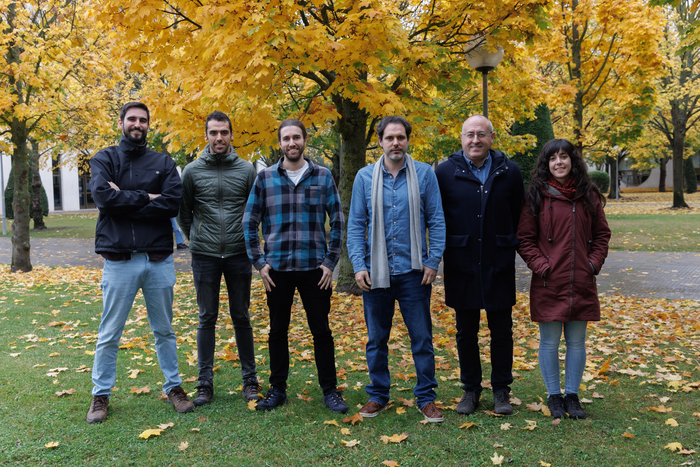At the Public University of Navarre (UPNA/NUP), scientists, who belong to the Smart Cities (ISC) and InaMat2 institutes, have remotely handled a composite that has been made out of thermoplastic and iron powder utilizing heat and magnetic fields. This helps achieve a “degree of control never seen before.”

The UPNA/NUP researchers who are the authors of this article. From left to right: Íñigo Ezcurdia, Xabier Sandúa, Josu Irisarri, Asier Marzo, Iñaki Pérez de Landazábal, and Itziar Galarreta. Image Credit: UPNA/NUP-Public University of Navarre
The newly-developed composite, which has been categorized as programmable matter, could be manipulated remotely in water, air, or within biological tissue. This sets the stage for the development of tactile displays, biomedical devices, as well as object manipulators.
The study was reported in the latest issue of the journal “Nature Scientific Reports,” and its authors are Josu Irisarri, Íñigo Ezcurdia, Xabier Sandúa, Itziar Galarreta, Iñaki Pérez de Landazábal, and Asier Marzo.
Programmable matter is defined as a material that has the potential of altering its properties in a programmatic manner.
It can change its shape, stiffness, or other physical properties in a controlled way. However, both procedures have limitations: the former, in terms of strength; and the latter, regarding the minimum size of the achievable details –spatial resolution–.
Asier Marzo, Researcher, UPNA ISC, UpnaLab
So far, optical or magnetic techniques have been utilized to regulate the matter in a remote manner.
Control of Matter Using Heat and Magnetic Fields
The scientists from UPNA/NUP employed a composite of thermoplastic and iron powder. The former is firm at 27 °C, but turns out to be malleable while subjected to heating in a process that can be reversed.
At the same time, it is possible for the iron powder to be mixed with the thermoplastic and attracted by magnetic fields. The compound was exposed to magnetic fields and thermal patterns.
As a result of this combination, “an unprecedented degree of control is demonstrated. The hot areas solidify when they cool down and the process can be repeated," says Josu Irisarri.
For this to be done, the compound has to be heated at particular locations, which causes it to be malleable and attracted by magnetic fields.
The scientists executed several remote manipulations with the help of light, heat, and magnets on the composite. For instance, a filament was heated at the center, thereby making it malleable.
Subsequently, a magnetic field is pulled from the sides to twist it along the pre-heated area. The filament was made to get solidified upon cooling down. This process was repeated numerous times to develop various letters with the help of a single strand.
In a second experiment, a sheet of material was made to be heated by a laser at particular points. Later, a magnetic field attracted these points and as they were cooled down, they turned out to be solid, developing a Braille pattern. This process was repeated for highly complicated patterns.
Furthermore, in the third experiment, a block of material was made to be heated with the help of infrared light and increased by a magnetic field to develop a column. After this, a point on the column was made to be heated, and again, with the help of a magnetic field, a secondary branch was pulled out, thereby developing a tree.
In the final test, insertion of the material was done into a lung simulator balloon, which seems to be optically opaque. It was heated with the help of microwaves, and when the magnetic fields were applied, the material present inside the balloon could be extended to a certain size.
The material could be bent, rotated, contracted, stretched, split, raised, fused, melted, and sculpted into Braille patterns or figures.
Complex Manipulations
We have demonstrated complex manipulations on 3D blocks, 2D sheets, and 1D filaments, which will have applications in tactile displays and object manipulation. Due to the low transition temperature and the capability of heating through opaque materials using microwave, the composite can be manipulated inside biological tissue, offering great potential for biomedical devices.
Asier Marzo, Researcher, UPNA ISC, UpnaLab
Other than tactile technologies, UPNA/NUP scientists anticipate other applications as well.
Journal Reference:
Irisaari, J., et al. (2022) Complex selective manipulations of thermomagnetic programmable matter. Scientific Reports. doi.org/10.1038/s41598-022-24543-5.